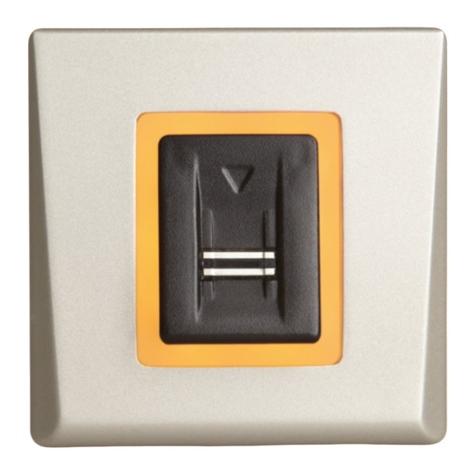
66250203 - V4.4 - 15/05/22
- 7 -
4000 Series Vandal Resistant Range
Art.4212 - Installation instructions
PROGRAMMING PARAMETERS
USER PARAMETERS
User par. menu Parameter Name Programming Method Permission Default value
1: Usr User name By panel and PC software All “ “
2: Flat Flat By panel and PC software All /
3: Code Code By panel and PC software All /
4: Fl. Floor By panel and PC software All /
5: En. Enable By panel and PC software All Enabled
6: Ph. Id Phone Id By panel and PC software Only Engineer /
7: Bl. Id Block Id By panel and PC software Only Engineer /
8:Tag Tag By panel and PC software All /
USER NAME
The user name can be up to 16 characters long and is displayed
during searching and calling.
Modify routine
• select user searching by name or at;
• press “1” button to enter into edit mode;
• type name;
• press to save or to delete characters or exit edit mode
without save.
FLAT
The at number is entered by the visitor to call a at. It can be 1
to 6 digits long.
Modify routine
• select user searching by name or at;
• press “2” button to enter into edit mode;
• type at number;
• press to save or to delete characters or exit edit mode
without save.
CODE
Access Code is entered by the user to open the door.
Modify routine depends on Mode setting: in COMPATIBILITY
MODE only one code is possible per user. Pressing “3” will allow
the code to be edited.
In NORMAL MODE multiple codes can be assigned to a user.
This routine is described in "Code management" on pag. 5
In both cases codes can be from 3 to 6 digits using keys 0 - 9. It
can be disabled by leaving it blank.
Modify routine (only for COMPATIBILITY MODE)
• select user searching by name or at;
• press “3” to enter into edit mode;
• type new access code;
• press to save or to delete characters or exit edit mode
without saving.
FLOOR
The oor eld displays the oor number of the user called. It is avail-
able only in NORMAL MODE and can be any value from“1”to“250”.
Modify routine
• select user searching by name or at
• press “4” to enter into edit mode;
• type oor number;
• press to save or to delete characters or exit edit mode
without save.
ENABLE
It species whether User is enabled or not. If a visitor tries to call
a disabled user typing the at number, display will show “NOT
FOUND” otherwise the intercom for that at will be called. In-
tercom specied by Phone Id and Block Id.
Modify routine
• select user searching by name or at;
• press “5” to enter into edit mode;
• press “5” to enable or disable;
• press to save or to exit edit mode without save.
PHONE ID
The phone ID represents the address of the intercom to call (Set
by the 8 way dip switches in the intercom).
Modify routine
• select user searching by name or at;
• press “6” to enter into edit mode;
• type Phone Id number;
• press to save or to delete characters or exit edit mode
without save.
BLOCK ID
Block Id eld species the address of Art.2206N. It can assume
values from “1” to “15”. This eld is visible only if the panel is set
to MAIN MODE (see "Panel mode" on pag. 11).
Modify routine
• select user searching by name or at;
• press “7” to enter into edit mode;
• type Block Id number;
• press to save or to delete characters or exit edit mode
without save.
TAG
The tags (key or fob) allow users to open the door. Three fob
code lengths are supported (2, 3 & 4 bytes). It is specied by Tag
width parameter (see "Fob width" on pag. 12).
User can be linked to more than one access code. The modify
routine is described in "Quick call" on pag. 5.
Art.4212 Audio/video digital front panel Programming




























